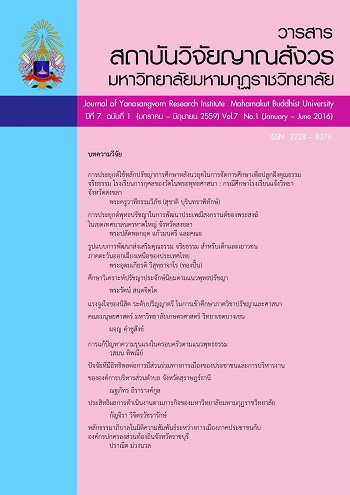SOLUTION OF FAMILY VIOLENCE ACCORDING TO BUDDHIST DOCTRINE
Main Article Content
Abstract
The objectives of this study were as follows : 1) to study a cause of violence in family, 2) to study a solution of violence in family, 3) to study the appropriate Buddhist doctrines to solve the problem of violence in family 4) to integrate a solution of violence in family according to Buddhist doctrines and 5) to offer a guideline and a new body of knowledge model in the solution of violence in family according to Buddhist doctrines. The thesis was a documentary qualitative research method. The data were collected through documentaries and In-depth interview by whom 10 key informant persons dividing into 4 groups, namely Buddhist part, government violence solutionist, private violence solutionist, and a good example family. The data were analyzed and synthesized for answering the objectives. The results of the study found that: The violence problems in family were derived into 3 levels and 6 causes, namely in the individual level composing of 1) aggressive and violent habit in the family level composing of 2) without good communication in family, and 3 without good planning in family, 4) age gapping of relation in family influenced technology and society, in the social level composing of 5) without good monetary planning and 6) wrong attitude and belief. The Buddhist doctrines being able to solve the violence problems could be divided into 3 sections namely 1) family planning section with Samajividhamma principle i.e., the same faith, the same right, the same sacrifice and the same decision, 2) a good duty activity section with 6 Disas or direction-principles, i.e., (1) the front direction referring to the interactive duty both parents and son and daughter, (2) the back direction referring the interactive duty both husband and wife, 3) good relationship in family section with 6 Saraniyadhamma principles. These should be done with the 1-3 good loving kindness actions through three ways, (4) sharing with each other, (5) without harming each other, and (6) reasonable co-decision together, 4) property management section with Bhogavibhaga 4. In order to integrate solution of violence in family with Buddhist doctrines could be done by changing behavior for solving 6 causes of violence, namely 1. Solving problem derived from attitude, social value and wrong belief is able to be done by adjusting the right thinking by which the violence, harming each other are not good without any execution. It should be trained to be a culture of non-violence in society. 2. Solving an aggressive and violent habit is able to be done by strongly keeping commitment on not showing an aggressive and violence through body and verbal, trying to change all bad habits, instead creating loving kindness and compassion in mind. 3. Solving bad communication in family is able to be done by sincerely and deliberately doing ourselves duties belonging to husband, wife and child. It must be done with loving kindness through body and verbal concretely. 4. Solving a problem of family planning is able to be done by coaching the family planning program on the themes of duty, thinking, decision, living together and co-solving problem together. 5. Solving a problem of monetary planning is able to be done by managing properties to increate benefit in several parts, working in a good job, not risky on the illegal work. It should be done by manage debit and credit properly and avoiding a cause of wrong way to lose properties. 6. Solving a problem of age gapping influenced with technological society is able to be done by keeping good relationship and good communication with each other in family, showing by loving kindness through body, speech and mind. The parents must pay the time for family, learning to understand the modern world as a part of live. A new body of knowledge of the thesis is to preserve Buddhist precepts, to cultivate concentration and wisdom based on the Buddhist Faith in order to solving violence in family on the level of individual family and society, so called “FPCW” Model.
Article Details
References
มหามกุฏราชวิทยาลัย.(2525). มูลนิธิ.พระไตรปิฎกและคัมภีร์อรรถกถา กรุงเทพมหานคร : โรงพิมพ์มหามกุฏราชวิทยาลัย.
กระทรวงการพัฒนาสังคมและความมั่นคงของมนุษย์. รายงานข้อมูลและตัวชี้วัดด้านความรุนแรงในผู้หญิงและเด็กหญิง. โครงการภายใต้การสนับสนุนของ UNDP ประเทศไทย. กรุงเทพมหานคร : กรมกิจการสตรีและสถาบันครอบครัว, 2554.
จิราภา เต็งไตรรัตน์ และคณะ. จิตวิทยาทั่วไป. พิมพ์ครั้งที่ 4. กรุงเทพมหานคร : สำนักพิมพ์มหาวิทยาลัยธรรมศาสตร์, 2547.
พรเพ็ญ เพชรสุขศิริ. การศึกษาปัจจัยที่มีผลกระทบต่อความรุนแรงในครอบครัวและความก้าวร้าวของเยาวชนไทย. กรุงเทพมหานคร : สถาบันบัณฑิตพัฒนบริหารศาสตร์, 2539.
แม่ชีวงเพชร คงจันทร์. “การศึกษาวิเคราะห์ความสัมพันธ์ระหว่างหลักพุทธธรรมกับหลักกฎหมาย : กรณีศึกษาพระราชบัญญัติคุ้มครองผู้ถูกกระทำด้วยความรุนแรงในครอบครัว”. สารนิพนธ์พุทธศาสตรดุษฎีบัณฑิต. บัณฑิตวิทยาลัย : มหาวิทยาลัยมหาจุฬาลงกรณราชวิทยาลัย, 2556.
พูนสุข มาศรังสรรค์. “การจัดการความรุนแรงในครอบครัวเชิงพุทธบูรณาการ”. วิทยานิพนธ์พุทธศาสตรดุษฎีบัณฑิต. บัณฑิตวิทยาลัย : มหาวิทยาลัยมหาจุฬาลงกรณราชวิทยาลัย, 2554.
แม่ชีวงเพชร คงจันทร์. “การแก้ปัญหาความรุนแรงในครอบครัวที่ปรากฏในคัมภีร์พระพุทธศาสนา”.สารนิพนธ์พุทธศาสตรดุษฎีบัณฑิต. บัณฑิตวิทยาลัย : มหาวิทยาลัยมหาจุฬาลงกรณราชวิทยาลัย,


